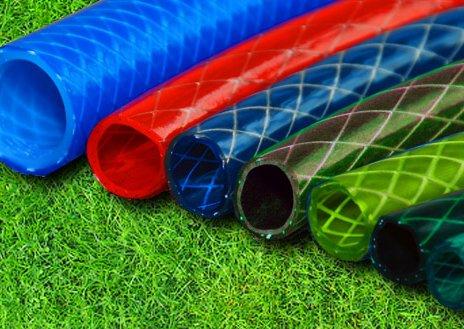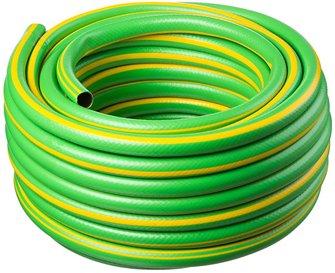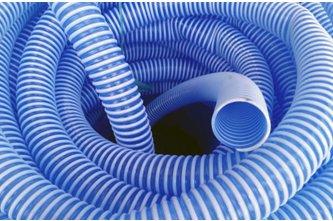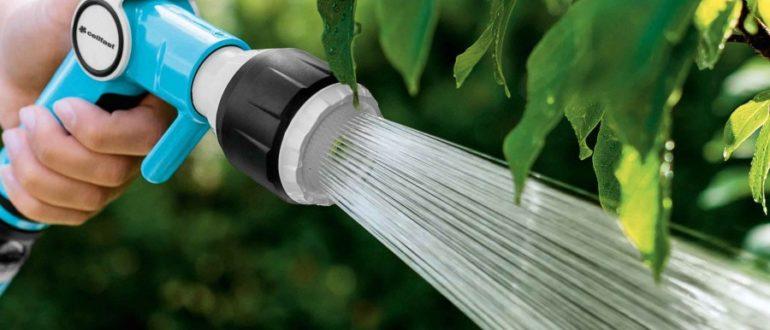The gardener or gardener knows the importance of the hose for watering purposes. However, when the question of choice did not arise earlier, since only rubber models were available, today the assortment is replete with its own variety. Even experienced summer residents are wondering which flexible pipelines are better to purchase. To know which hose to choose for irrigation, you need to read the recommendations.
Content
Irrigation Hose Selection Options

Watering hoses will make the life of a summer resident or gardener much easier. Such a simple device can significantly reduce the labor intensity of caring for green spaces. Flowerbeds, garden, plot and vegetable garden in any situation will have a well-groomed look. Irrigation hoses can be different, and the quality of irrigation will depend on their performance.
Specifications
It is imperative to determine the technical characteristics:
- The length is measured and is the distance from the point of water intake to the watering point.
- The diameter of the flexible pipe is taken in accordance with the diameter of the connection valve and will usually be from 1/2 / to 1ʺ.
- To determine the working head, you need to know the head at the entrance and its loss in length (approximately 1 m vertically to 7-10 m horizontally). This indicator is combined with the corresponding ones, which are indicated in the passport.
- In addition, the operating temperature values are taken into account, in the range of which the device should work properly.
Manufacturing material
They select the material of manufacture, starting from:
- number of layers;
- the presence of reinforcement;
- the degree of transparency;
- performance indicators.
Certain details are taken into account:
- 1 layer is calculated for approx. 5 bar head;
- softer rubber will last longer;
- nylon braid is considered more durable than vegetable braid;
- mesh reinforcement is more effective than cruciform;
- transparent pipes are prone to overgrowing with algae;
- with an increase in the number of layers, the quality of operation will improve and the price will rise.
Design features
The emphasis should also be placed on models with structural characteristics. These include:
- oozing drip models;
- sprinklers that create different spray intensities;
- spiral and Xhose versions extending several times.
Storage and operation
Despite the increased degree of durability of the same PVC hoses, such garden equipment requires careful storage and use, even the above materials will not be an exception. It is necessary to follow such simple tips, the irrigation system will be able to serve the period specified by the developer without effort:
- After removing the hoses for storage inside the room, it is optimal to carefully reel them into coils. They should not be thrown directly onto the floor, they can be damaged by rodents. It is advisable to wrap them inside a bag or package and hang them on a hook on the wall.
- Even hoses that have a higher positive temperature limit should not be stored in the hot sun. They are placed in a package inaccessible to solar radiation or covered with a tarpaulin.
- Do not put a bucket of water, wheelbarrows, carts and other heavy objects on the hoses.
- In the process of carrying the hose along with you to another bed, it is necessary to ensure that it does not rub against an acute angle and objects.
- If you need to increase the water pressure, you should do it slowly.
- The possible pressure limit is not exceeded, otherwise the hose may burst.
- Before removing the hose to the household. the room, surplus liquid is drained off without fail and it dries out completely. This prevents the formation of mold and other pathogenic microorganisms.
Working pressure selection
The choice of working pressure involves the selection of the wall thickness of the hose. The most simple 1-layer devices without reinforcement can withstand a pressure of no more than 2 bar, while the most reliable 3-layer reinforced irrigation systems can freely withstand a pressure of 5-6 bar. Therefore, when it is found that the fluid pressure in the area is extremely high, then you should abandon the purchase of thin-walled models.
Otherwise, they will simply crack or burst during use. It is optimal not to save money and buy the most modern and modified types of irrigation systems. The pressure inside the system drops or rises, drops are not excluded, but the user will be ready and will not harm the irrigation system.
Temperature range selection
Most of the hoses are used during warm and hot periods. Therefore, irrigation systems must have an upper temperature limit of at least +40 degrees. However, at the same time, it should be borne in mind that in the winter period of time, the hoses remain on the site or are removed to the household. premises. Not every such building will be heated, therefore the lower limits should reach an indicator of at least -20 degrees. You should choose products with a wide range of temperature indicators, the user will save himself from expansion or cracking of the walls.
Additional accessories for watering hoses
In addition to the main characteristics of the irrigation system, you should pay attention to additional accessories that make the use of the hose much easier. The most important are:
- Coil. They help make hose storage more correct and safer for the device. There are transportable and stationary ones. The latter are fixed, for example, on the wall of the building. The choice of a reel should be based on the characteristic features of the site - when there is no need to move the hose, it is possible to choose stationary products. At the same time, the mounting location should be carefully selected as it will become difficult to move the stationary coils later.
- Cart. The transportation of the main unit is simplified. It is a mobile structure on wheels to which a hose reel is attached.
- Pistol. This device makes it possible to control the intensity of watering, which is extremely important, since different plants have their own preferences for watering.
Types of hoses for irrigation
The choice of material for the irrigation system is quite an important task that will determine the life of the device. It is necessary to find out in detail which type of material from which modern irrigation systems are made will be the best. To do this, one should take into account their key characteristics, the advantages and disadvantages of each.
Rubber hoses

The most popular and accessible variety, which is actively used by a large number of users. It is able to withstand a water pressure of more than 8 atm., With proper use, the service life will be approximately 10 years. The conditions for using the hose are universal.Flexible rubber hoses are suitable for manual and automatic watering of plants and area. They are suitable for industrial and car wash use. In order to supply drinking water, the food version is used, where there are no toxic substances. The rubber hose is able to maintain its own characteristics in large temperature ranges –30 +90 degrees.
Pros:
- option to store in an unheated room without damaging the hose;
- the structure of the irrigation system will remain stable even under prolonged exposure to ultraviolet radiation;
- not affected by temperature changes;
- will not succumb to the destructive influence of chemical reagents;
- resistant to external deformation;
- differs in long terms of use.
Minuses:
- has a significant mass, which will make its transportation across the site uncomfortable and traumatic for vegetation;
- rubber is classified as a toxic material, therefore it is not at all recommended to use such a product in order to organize systems with drinking water (very cheap hoses can harm plants).
PVC hoses

Models made of polyvinyl chloride can be the most primitive - 1-layer without reinforcement, and quite reliable - 3-layer with a coating that reflects light. It should be noted that transparent irrigation systems are not recommended for laying along the beds, since under the influence of ultraviolet radiation, over time, its inner surface will turn green and become overgrown with pathogenic microflora.
PVC hose can withstand water pressure in the range of 1.5-3 amt. The wall thickness is minimal (1.5 mm) and thicker (3 mm). A characteristic feature of such a product will be that it is suitable for watering vegetation only during their growing season.
Pros:
- when purchasing a reinforced multilayer product, the user will receive a product that can serve for approximately 35 years;
- reinforcement is performed in the form of cross-shaped intersections, which will enable the walls to withstand pressure up to 40 bar;
- multilayer PVC hoses suggest the presence of food and non food plastic, which will create barriers to the growth of algae inside the cavity;
- for a long time, irrigation systems made of such material will withstand constant pressure and provide a stable flow of water;
- adequate price.
Minuses:
- a simple 1-layer hose is extremely thin, as a result of which it undergoes bending, breaking, twisting, and therefore will soon lose its performance;
- PVC products are subject to rapid fading under the influence of ultraviolet radiation;
- during application at temperatures less than -5 degrees, they will soon lose their own elasticity;
- the formation of algae and pathogenic microflora inside the walls of transparent models is permissible;
- unreinforced irrigation systems have a service life of less than 3 years.
Plastic hoses

Such a product can easily withstand a water pressure of more than 8 atm. It can be used at any time for regular watering and for other horticultural purposes. Its structure and appearance will remain stable and will not change under the influence of temperature indicators (-50 + 90 degrees). This will make the thermoplastic elastomer hose virtually universal.
Flexible plastic pipelines are suitable for watering gardens and vegetable gardens, personal plots. Since they are short-lived, they are used as temporary devices in the country, in the farm and greenhouse economy.
Pros:
- increased frost resistance;
- even during storage in an unheated room, no kinks form on the hose;
- the surface does not slip, therefore, it will make the use of the hose extremely comfortable (even with high water pressures, the device will not slip out of the hands);
- resistance to twisting;
- high plasticity and flexibility;
- low weight of the device;
- resistance to the influence of ultraviolet radiation and a variety of chemicals. reagents;
- long period of operation - approximately 15 years.
Minuses:
- quickly deforms and easily wrinkles during bending;
- formation of limescale inside.
What to look for directly when buying
During the acquisition, you should focus on the key characteristics of the device. To buy high quality garden hoses for long term use, you should read the following guidelines:
- Opaque products are selected, this will prevent the formation of pathogenic microflora and greening of the walls.
- It is not recommended to buy cheap products from Chinese manufacturers with a persistent unpleasant naphthalene aroma. It is extremely unpleasant to work with such a device, and the aroma sometimes remains persistent for a long period. You should think about the quality of the materials used, which have a similar smell. It is possible that they harm a young plant.
- Emphasis should be placed on the appearance of the device. The shade must be uniform along the length. The coating should be smooth, but not slippery in your hands. In addition to keeping the hose firmly in the palm of your hand, it must also move freely over the surface.
- When purchasing spiral hoses, consider the area of the site. On a large territory, it is ineffective. And watering beds of this scale by hand is extremely exhausting and time-consuming.
- The shortest length of the garden hose equals the longest distance from the water supply to the farthest bed.
- When the user was unable to determine the diameter of the hole inside, you should seek advice from the seller.
- You should purchase models with a wide range of operating temperature indicators.
Which irrigation hose to choose
The question often arises as to which irrigation hose is better to choose:
- The most popular and practical ones are models made of rubber and PVC or silicone (reinforced). The former are created from recycled materials and are toxic - they are suitable for watering. Only food versions will be drinkable.
- Corrugated plastic and nylon are devices with short-lived operation, however, they are cheap, therefore it is optimal to store them in stock and use them sporadically. If you wish to use it, you must take into account that they are designed for pressures up to 5 bar.
- In order to ensure the greatest supply of water per unit of time, choose a diameter of 3 / 4ʺ, 5 / 8ʺ, 1ʺ. When the pressure is up to 2 bar, the optimum size is 1 / 2ʺ.
- For the convenience of use, an auxiliary cart with a reel is purchased. Alternatively, it is possible to simply purchase the stretching spiral version or the Xhose modification, as a result of which convenient watering of the flower bed will be guaranteed.
- If irrigation is needed, you should purchase oozing hoses with small holes along the length and flexible special drip irrigation pipes with 3 channels. They can be laid near the roots of the plant on the ground and in the thickness.
- To simulate natural watering, sprinklers with a nozzle are purchased - such devices function in various modes, including automatic.
Often the question arises of how to choose a hose for watering a garden. To find out how to purchase a quality product, you should read these recommendations.



